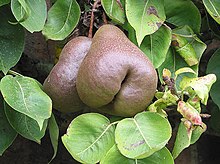Black Worcester pear

The Warden pear takes it name from the Cistercian Abbey of Warden in Bedfordshire.
The name of 'Warden pear' may refer to any one of a number of pear varieties that do not truly ripen and must therefore be cooked to be edible. They are used to make "Warden pies"; "I must have Saffron to colour the Warden Pies" (Shakespeare, The Winter's Tale iv.3). In Two Fifteenth-Century Cookery-Books, edited by Thomas Austin for the Early English Text Society (Original Series, Volume 91), a recipe is given (p. 51) for "Quyncis or Wardouns in past".
Alternatively, the name may be used to refer specifically to the variety known as "Black Worcester or Parkinson's Warden."[1]
Black Worcester was recorded as being grown by monks at the Abbey as early as 1388. As long keeping fruit, it formed an important part of the winter diet until root-crops were introduced. The fruit is larger than average and the flesh hard and coarse, but is reported to be excellent when stewed. It may also have been used to make perry.
Heraldry
Warden pears formed part of the provisions of the troops at Agincourt in 1415, where Worcestershire bowmen carried banners depicting a pear tree laden with fruit.[citation needed]
On Queen Elizabeth I's visit to the city of Worcester in August 1575, the city authorities had a fruit-laden tree transplanted to the Foregate in her honour. So admiring was she of the good management that had allowed the fruit to remain unplucked that she ordered “3 pears sable” to be added to the city's coat of arms, which probably gave rise to the name "Black Worcester".[citation needed]
The warden's pear is rarely distinguished in blazon, if not in visual form, from the regular pear when there is a pun to be made on the name "Warden."[2]
References
- ^ "Warden Abbey Vineyard: Warden Pears". Retrieved 2008-06-01.
- ^ "A GLOSSARY OF TERMS USED IN HERALDRY by James Parker". Retrieved 2008-06-01.

